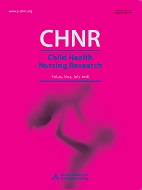

- P-ISSN2287-9110
- E-ISSN2287-9129
- Frequency Quarterly
- PublisherKorean Academy of Child Health Nursing
-
CCL

- Indexed bySCOPUS,KCI
You can use ACOMS+ service with an AccessON integrated member account.
※ If you are already an AccessON integrated member, go back to the journal’s website and login.


